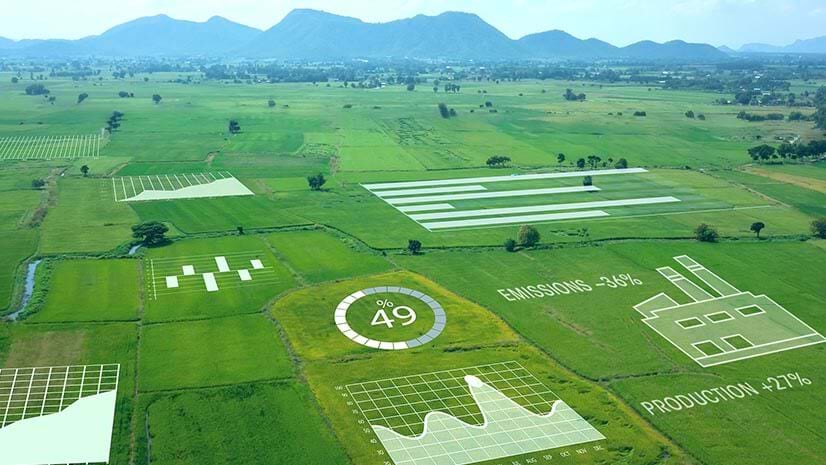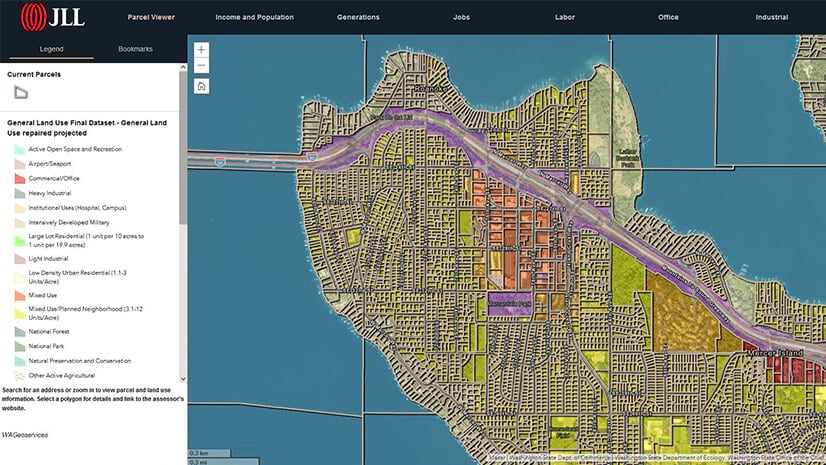To create strategic value from business intelligence, companies need dynamic employees who are “bilingual” in today’s information economy. These professionals communicate effectively in the realm of data and analysis, but also understand how to calculate ROI—the language of executives.
In the growing field of location intelligence, a map-based form of business intelligence, the need for such versatile figures has even led to the coining of a new phrase—spatial business transformers. As mediators between IT and the C-suite, these deft communicators play an essential role in ensuring that data analysis contributes to an organization’s strategic goals.
A New Class of Location Analysts
Alina Shemetova, a GIS supervisor at Denver-based oil and gas exploration company SM Energy Company, grew up with a head start on the bilingual part. Born in Ukraine in 1990—a year before the USSR dissolved—she moved to the US at the age of seven with her parents. A love of maps eventually landed Shemetova in her current position, using insight from a geographic information system (GIS) to help create business value and help make SM Energy’s operations more efficient and safe.
Oil and gas companies like SM Energy increasingly rely on data analysis to improve everything from where they drill wells and place facilities to how they ensure environmental health and safety.
Shemetova represents a rising class of GIS experts who use location-based data to help businesses make better, less costly decisions. (See sidebar, “Speaking of ROI.”) Shaped by her upbringing in a country that prides itself on fighting the odds, she exudes excitement and confidence in her quest to demonstrate the value of location intelligence, especially in cutting costs and enhancing safety.
“We’ve got the resources,” she says. “We have really smart people. We have really good technology. We can use all that to drive business value and save the company money.”
Back in the USSR
Shemetova doesn’t find it surprising that she developed an interest in cartography, a field that combines art and science. In the USSR, her father was a painter and her mother an electrical engineer. Growing up, Alina was also deeply influenced by her grandfather, Dr. Valentin Bryantsev. As an oceanographer, he was part of the first joint US–USSR effort to research Atlantic fisheries from 1967 to 1973. His visit to Woods Hole Oceanographic Institution in Massachusetts during that time was an early glimpse into a new world of opportunity.

Not long after Shemetova was born, her parents grew frustrated by the lack of opportunities in Ukraine and moved to South America, hoping to eventually make their way to the US. They took jobs as contractors and cooks’ assistants, determined to create a better life for their young family. Eventually they won a green card in the immigration lottery, putting them on a path to US citizenship. In 1997 the family moved to Leadville, Colorado.
Shemetova found her upbringing and personality well-suited to the American culture and economy. “Like most Ukrainians, I have a constant hunger to prove that I am capable, no matter the circumstances. Now I’m in a country that allows you to be rewarded for it. However, I’m always going to remember what it was like for my parents not to have had that, and how much they gave up to provide me with a different path.”
The ABCs of GIS
She attended the University of Colorado Denver, where she majored in geography with a focus on environmental studies. Her enthusiasm was immediately apparent. It was at CU Denver, a stronghold of GIS education in the West, that Shemetova first absorbed the lessons that would define her career as a spatial business transformer.
“She was one of the best, brightest students we have had in years,” says Rafael Moreno-Sanchez, an associate professor in the department of geography and environmental sciences at CU Denver. “I remember her passion for geography and geographic information science and technology. She was very excited about it, embracing the material beyond just doing the coursework and homework.”
In his classes, Moreno-Sanchez emphasizes that pure technical savvy will only get students so far. People skills, a facility for communication, and the ability to be a team player are all essential in driving change within an organization.
After graduating in 2013, Shemetova was hired at SM Energy as a GIS analyst. At first, she was content to occupy herself with the nuts and bolts of the technology. “I was very technical, very head-down,” she recalls. But her manager and mentor—a GIS visionary of sorts—pushed her to think about the larger ramifications of the technology within the business, and how to interact with company business leadership.
That outlook became a necessity when her manager left the company. Now Shemetova was the one tasked with understanding how GIS could fit best within the larger vision and operation of SM Energy. “I had to climb that peak of really being able to translate it to management,” Shemetova says.
An Ambassador for Location Intelligence
SM Energy had first employed GIS in its land department, using maps to track leases for the land on which it operates wells. But location data plays a role throughout the full life cycle of a well, and the opportunities to employ location intelligence more broadly were numerous.
“They would come to us and say, ‘We just presented a report to our VP, and the leasehold doesn’t match,’” Shemetova says. “I would find out after the fact that they weren’t connected to dynamic, live data.”
Her first order of business with the GIS team she now led was to build a foundation that ensured data accuracy. This objective helped create a new habit and mind-set for Shemetova, who began to look for other contexts in which location intelligence could drive business value.
“Every time, we go back to the same thought: Does this application have spatial awareness?” Shemetova says. “If not, how can we make it more aware? How can we make sure the data that’s consumed by it is more spatially intelligent?”
Learning more about the thought process of decision-makers inside and outside the company led to Shemetova’s next important insight. She realized that by anticipating the needs of colleagues related to location intelligence, she could help them do their jobs better and create more awareness around the potential of GIS, powering a cycle of progress. “Anticipating the elements of the foundation—which can then scale to the demand of the business—was really crucial,” she says.
The Common Language of Business Value
Anticipating meant getting in the room with executives—gaining the proverbial seat at the table—in order to embed location intelligence in decision-making early on. When leaders understood from the start how GIS could be leveraged, it made it easier to arrive at data-driven solutions faster.
Moreno-Sanchez thinks Shemetova’s versatility helped her facilitate that change. “It has served her well, being able to talk to people and communicate, having the skills to deal with people outside of GIS.”
As Shemetova came to better understand the perspective of executives, she found a common language with them—one focused on cost and safety. For company leadership, nothing takes priority over the physical well-being of employees, contractors and the communities in which SM operates, as well as the assurance that resources aren’t wasted. Shemetova directed the full power of location intelligence toward those strategic goals.
One of her biggest wins came in gaining company-wide adoption of a GIS-enabled mobile app. SM’s fieldworkers use the app to collect and instantly share data, including photos and condition reports, on chemical equipment used at oil wells. Capturing such data in real time reduces paperwork and increases awareness for the lease operator in the field and the engineer in the office. It also enhances safety by tracking workers’ exposure to H2S, or hydrogen sulfide, dangerous even in small concentrations.
By implementing the field app, the GIS team helped SM achieve two strategic goals: creating a safer workplace and saving upwards of 30 percent on the $10 million chemical program.

It’s that push and pull of being the middleman between the business and IT. We want to make sure they realize that a spatial component is as crucial as the actual data that they’re delivering to the business.
The Power of Partnerships
In her ambition to uncover business value through location intelligence, Shemetova was aided by a strong sense of curiosity—a trait that can strengthen anyone in “business bilingual” roles, especially when combined with the urge to find mentors and partners.
“Alina sought us out at a recent petroleum users group (PUG) conference with some targeted questions about technical and process scenarios,” says Brian Boulmay, Integration Director, BP DataWorx. “Since then we have met with her and her management on several occasions, sharing best practices and lessons learned. This is the value of the PUG community—people who are open to sharing and learning from others. Alina is continuing that tradition and will be a very valuable member of the larger professional community.”
Shemetova put this principle into action recently when the position of GIS supervisor opened at SM Energy. Applicants were asked how location intelligence was best being employed at the company, and how it could be used more effectively in the future. Shemetova decided to pose the queries to business users who had worked with SM Energy’s GIS team. She edited their answers into a short video montage—a media-savvy distillation of the lessons Shemetova learned over the course of six years as a GIS communicator. In July, she got the job.
Personal and Business Growth
Leading technology adoption in an organization poses challenges regardless of the platform. For those charged with the task, a degree of personal investment—including a passion for finding solutions through data, a desire to bring others along with you, and genuine interest in others’ perspectives—can be transformative. It also doesn’t hurt to be the kind of person who feeds off overcoming obstacles, finding learning opportunities outside one’s comfort zone.
Shemetova traces those character traits to her dual national identity as a Ukrainian-American. It’s helped her find her voice in the business world, learning to communicate up and down the chain of command.
“SM Energy has provided me with endless opportunity,” she says. “Yet it’s in my hands to continue finding comfort in the discomfort of challenges as I pave the path of my career.”












